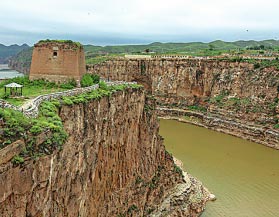Yellow River and Great Wall shake hands here
Updated: 2016-08-29 07:43
By Sun Ruisheng/Yang Cheng(China Daily)
|
||||||||
 |
|
View of Old Cow Bay on the Yellow River, in Pianguan, with its old tower on the remaining Great Wall section and the Inner Mongolia autonomous region just across the river. [Photo by Jiang Dong/China Daily] |
Accompanying this is an old fable about how an old cow used the powers that it had been granted by the gods to furrow a magnificent deep river bend in Pianguan county, Shanxi province, which leant itself in naming the area, Old Cow Bay, which has been recognized as a grand sight for centuries and was added to the list of China's most beautiful valleys by China National Geography magazine.
And, just across the river from the Shanxi side, to the north and west, and with the same high, steep loess cliffs, lies the neighboring Inner Mongolia autonomous region, so that Old Cow Village on the Chinese side is the first village that the river enters in Shanxi province.
Now, Old Cow Bay is prominent not just for its magnificent view of the mother river way down below as it snakes its way around a large S-shaped bend. It is also, in the words of Dong Yaohui, vice-chairman of the China Great Wall Association, the only place in China where "the Yellow River 'shakes hands' with that wonder of the world, the Great Wall."
The county, which administers the village, has some 500 kilometers of the remaining Great Wall, built during the Kingdom Zhao period (403-222BC), Qin Dynasty (221-206 BC), Northern Wei Dynasty (386-534) and Ming Dynasty (1368-1644) with 49 castellated towers and out of them 29 are well preserved. There are also some 1,000 other towers, making good use of a variety of Pianguan materials such as stones, bricks, and rammed earth, giving it a certain prominence in the country, according to the association.
And the bay gives visitors a rare opportunity to examine how several lines of the Great Wall come together. The wall generally employs several lines with the farthest out being built as the first line of defense while others protect the interior, so, as Dong goes on to say, "All these indicate that Old Cow Bay and Piansguan county have serious historical value."
He Jiao, an Old Cow Bay Administration official, explained that in recent years, more tourists have made this a starting point for a grand walking trip along the Great Wall, and, he continues, "They can average about 25 kilometers a day and take 36 days in all to reach Beijing."
He has worked for the administration for six years now and says that the tourists are growing in awareness of the need to protect the Great Wall and that some of the Wall's remaining sites have undergone renovation, but concludes by saying that some scientists are of the opinion that "maintaining them as they are now is the best way to preserve them".
Pianguan county's head official, Qu Jun'an, told China Daily that the area is just one part of China's vast loess plateau and more greenery is really the a key to preserving not just North China's environment but the ancient Great Wall as well.
To make sure that this happens, Qu notes, county records show that, for the 2011-15 period, they increased the amount of forest coverage by planting 3,333 hectares of trees every year.
- Bolivian deputy interior minister killed by miners: report
- In photos: Great Dorset Steam Fair 2016
- Historical towns before and after Italy's earthquake
- Car bomb kills at least eight at police headquarters in Turkey
- Brazil's Senate begins Rousseff's impeachment trial
- Arts festival aims to unite cultures

 World's top 10 largest banks by assets
World's top 10 largest banks by assets
 Sand sculptures to welcome the G20 Summit
Sand sculptures to welcome the G20 Summit
 Historical towns before and after Italy's earthquake
Historical towns before and after Italy's earthquake
 College prepares 300 sleeping mats for parents
College prepares 300 sleeping mats for parents
 Ten photos from around China: Aug 19 – 25
Ten photos from around China: Aug 19 – 25
 Top 5 fitness bands in customer satisfaction
Top 5 fitness bands in customer satisfaction
 Orangutan goes shopping in Southwest China
Orangutan goes shopping in Southwest China
 Prince William and Kate visit charity orgarnization
Prince William and Kate visit charity orgarnization
Most Viewed
Editor's Picks

|

|

|

|

|

|
Today's Top News
Trump outlines anti-terror plan, proposing extreme vetting for immigrants
Phelps puts spotlight on cupping
US launches airstrikes against IS targets in Libya's Sirte
Ministry slams US-Korean THAAD deployment
Two police officers shot at protest in Dallas
Abe's blame game reveals his policies failing to get results
Ending wildlife trafficking must be policy priority in Asia
Effects of supply-side reform take time to be seen
US Weekly

|

|







